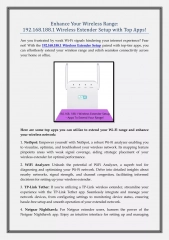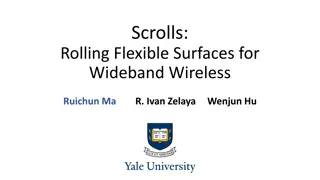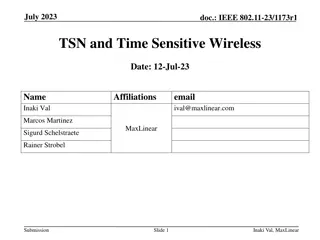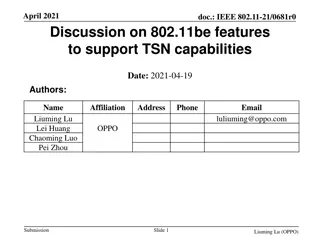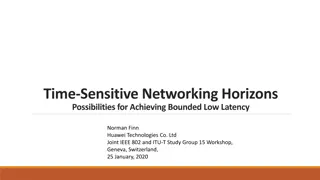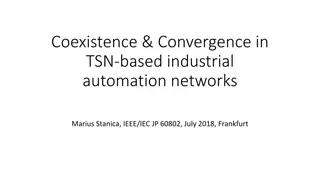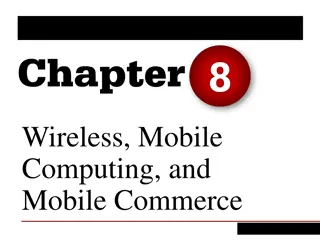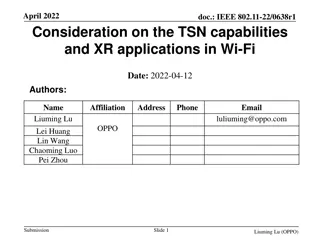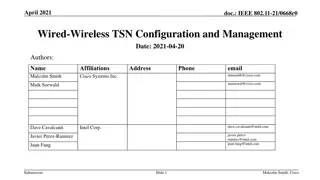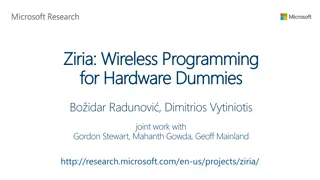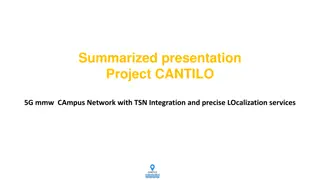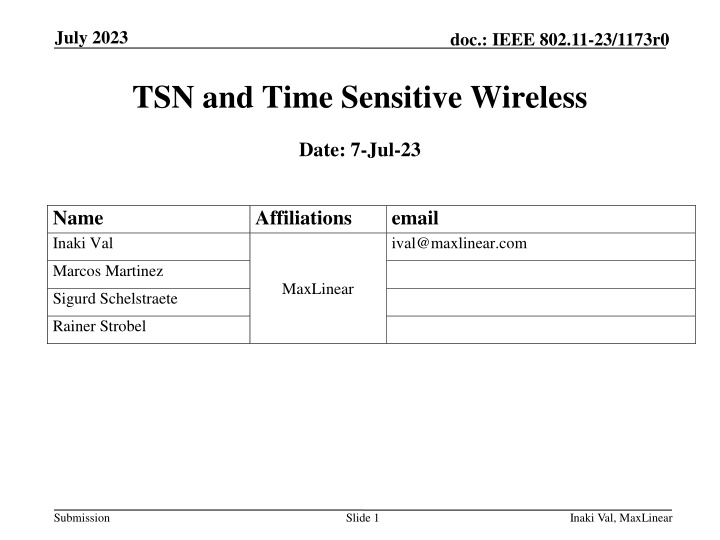
Time Sensitive Networking in IEEE 802.11
Explore the relationship between IEEE 802.11 and Time Sensitive Networking (TSN), clarifying terms and standards, and addressing latency improvement and Quality of Service enhancements in wireless networks. Discover how TSN aligns with existing standards and the benefits it brings to network reliability and latency reduction.
Download Presentation

Please find below an Image/Link to download the presentation.
The content on the website is provided AS IS for your information and personal use only. It may not be sold, licensed, or shared on other websites without obtaining consent from the author. If you encounter any issues during the download, it is possible that the publisher has removed the file from their server.
You are allowed to download the files provided on this website for personal or commercial use, subject to the condition that they are used lawfully. All files are the property of their respective owners.
The content on the website is provided AS IS for your information and personal use only. It may not be sold, licensed, or shared on other websites without obtaining consent from the author.
E N D
Presentation Transcript
July 2023 doc.: IEEE 802.11-23/1173r0 TSN and Time Sensitive Wireless Date: 7-Jul-23 Name Inaki Val Affiliations email ival@maxlinear.com Marcos Martinez MaxLinear Sigurd Schelstraete Rainer Strobel Submission Slide 1 Inaki Val, MaxLinear
July 2023 doc.: IEEE 802.11-23/1173r0 Abstract Discuss relationship and dependencies between 802.11 and 802.1 Time Sensitive Networking (TSN) Clarify the term TSN in the context of 802.11 Define Time Sensitive Wireless in 802.11 Submission Slide 2 Inaki Val, MaxLinear
July 2023 doc.: IEEE 802.11-23/1173r0 Introduction UHR targets the improvement of packet delivery by reducing the transmission latency and enhancing network reliability [1] This target can also be identified as an overall Quality of Service (QoS) enhancement Several RTA use cases with low-latency requirements have been identified [2], and many other use cases would benefit from QoS improvement features Different features are being proposed for latency, reliability, and QoS improvement: Multi-AP [3], preemption [4], and low-latency scheduling [5] Submission Slide 3 Inaki Val, MaxLinear
July 2023 doc.: IEEE 802.11-23/1173r0 Problem Statement In this context, the term Time Sensitive Networking (TSN) is often used, sometimes as synonymous with latency improvement Several questions arise: What do we mean with TSN in UHR? What is the relationship with existing TSN standards? Where do we need TSN and Time Sensitive Wireless in 802.11? Let s clarify the use of these different terms Submission Slide 4 Inaki Val, MaxLinear
July 2023 doc.: IEEE 802.11-23/1173r0 Time Sensitive Networking (TSN) - summary TSN refers to a set of IEEE 802.1 standards that offer an Ethernet network with the following characteristics [6]: E2E Bounded Latency Global Clock Reliability Availability IEEE 802.1AS IEEE 802.1CB TSN IEEE 802.1Qcc IEEE 802.1Qav IEEE 802.1Qci Resource Management Bounded Latency IEEE 802.1Qbv IEEE 802.1Qbu TSN can be built on a selection of these standards, depending on the features needed: pick & choose TSN can be seen as an Ethernet multi-switch network based on a TDMA MAC (e.g. IEEE 802.1Qbv) and a global common clock (e.g. IEEE 802.1AS) over the whole network TSN Ethernet switch allows critical traffic and blocks the rest at certain periodic time windows Simultaneous time-coordinated TSN switches guarantee end-to-end bounded latency Submission Slide 5 Inaki Val, MaxLinear
July 2023 doc.: IEEE 802.11-23/1173r0 Evolution of TSN While TSN was originally defined for IEEE 802.3 Ethernet interface, TSN aims to be extended to other wireless media, such as: IEEE 802.3 Ethernet, IEEE 802.11, 3GPP 5G Each of the MAC/PHY interfaces needs to support TSN capabilities 5GS integration into TSN is already standardized under 3GPP Release 16 and beyond This approach can be called Generic TSN Application TSN Device Network Stack Generic TSN TSN Common Layer IEEE 802.3 IEEE 802.11 3GPP 5G/6G Others Submission Slide 6 Inaki Val, MaxLinear
July 2023 doc.: IEEE 802.11-23/1173r0 TSN and IEEE 802.11 First steps towards TSN and 802.11 integration already done 802.1AS Time synchronization TSN standard supports 802.11 MAC/PHY interface 802.11 defines time-sensitive feature (i.e., FTM) 802.1 defines the TSN standard (i.e., 802.1AS) building on this 802.11 feature Additionally, IEEE 802.11 is defining new features that could be leveraged by TSN, for instance: Feature IEEE 802.11 TSN Time Synchronization TSF, TM, FTM IEEE 802.1AS EDCA IEEE 802.1Q VLAN Traffic Classification & Prioritization Stream Classification Service Stream Classification Trigger-based Access Scheduled Operation Restricted TWT IEEE 802.1Qbv TAS Multi-AP Coordination Reliability & Availability Multi-Link Operation IEEE 802.1CB Submission Slide 7 Inaki Val, MaxLinear
July 2023 doc.: IEEE 802.11-23/1173r0 In summary TSN and IEEE 802.11 TSN is an ecosystem of standards within 802.1 A Generic TSN can be followed allowing a common IEEE 802.1 TSN layer to make use of TSN tools offered by each technology 802.11 defines time sensitive features, that in future may (or may not) be leveraged by TSN. Submission Slide 8 Inaki Val, MaxLinear
July 2023 doc.: IEEE 802.11-23/1173r0 Time Sensitive features in UHR (1/2) Time sensitive features in UHR cover two different needs: a) Real-Time Applications (RTA) with bounded-latency requirements and periodic traffic patterns [2]: Online gaming, Professional Audio/Video, Industrial Automation, Augmented and Virtual Reality Strict time-sensitive requirements for correct operation This behavior can be covered by implementing TSN tools and using the Generic TSN approach Submission Slide 9 Inaki Val, MaxLinear
July 2023 doc.: IEEE 802.11-23/1173r0 Time Sensitive features in UHR (2/2) b) Multi-AP Coordination and QoS enhancement Some forms of Multi-AP coordination need common clock Time-coordinated operations: C-TDMA, Coordinated r-TWT, C-OFDMA, Joint transmission QoS enhancements: IoT, Video streaming, Online Audio/Video, Remote Surveillance UHR needs to provide the tools for coordinating the time-aware operation in Multi-AP environments Submission Slide 10 Inaki Val, MaxLinear
July 2023 doc.: IEEE 802.11-23/1173r0 TSN Interpretation (1/3) Discussions around Time sensitive in the context 802.11bn could have two different interpretations: a) Incorporate IEEE 802.11 into Generic TSN b) Define a set of 802.11 time-sensitive features to be used in stand-alone 802.11 networks So far, both aspects have been covered by using implementing TSN which does not seem correct Submission Slide 11 Inaki Val, MaxLinear
July 2023 doc.: IEEE 802.11-23/1173r0 TSN Interpretation (2/3) a) Incorporate IEEE 802.11 into Generic TSN Mainly for strict time-critical RTA use cases that require an end-to- end TSN solution For the end user, connecting an Ethernet TSN device or using an 802.11 interface will lead to similar experience, maintaining the performance and requirements It could imply a high complexity, implementing the selected 802.1 TSN standards for guaranteeing interoperability and strict deterministic behavior Probably not directly applicable to time-aware 802.11 features (e.g., Multi-AP coordination) Let s call this Generic TSN incorporating 802.11 Submission Slide 12 , MaxLinear
July 2023 doc.: IEEE 802.11-23/1173r0 TSN Interpretation (3/3) b) Define a set of 802.11 time-sensitive features to be used stand-alone in 802.11 networks Improve the QoS management and the behavior of time-sensitive traffic in 802.11 networks Provide the tools for coordinating the time-aware operation in Multi- AP environments Not necessarily following/implementing the 802.1 TSN standard TSN use cases (time-critical) may leverage these capabilities for their applications Let s call this Time Sensitive Wireless Submission Slide 13 Inaki Val, MaxLinear
July 2023 doc.: IEEE 802.11-23/1173r0 Summary The term TSN is currently used loosely to refer to both interpretations, leading to possible misunderstandings: a) Generic TSN incorporating 802.11 b) Time Sensitive Wireless (a) would probably make use of (b), but (b) could exist independently Following the approach for TSN time synchronization over 802.11: (a) built in the scope of 802.1, with 802.11 hooks in the scope of 802.11 while (b) in the scope of 802.11 Submission Slide 14 Inaki Val, MaxLinear
July 2023 doc.: IEEE 802.11-23/1173r0 Conclusion UHR targets time-sensitive applications UHR is proposing new features which will require time-sensitive tools These new features could enable TSN capabilities We have identified two different interpretations of TSN term in the context of 802.11 a) Generic TSN incorporating 802.11 b) Time Sensitive Wireless 802.11bn WG should clarify this terminology Submission Slide 15 Inaki Val, MaxLinear
July 2023 doc.: IEEE 802.11-23/1173r0 Proposal UHR should not define time-sensitive features exclusively within the context of TSN Time sensitive features should be primarily intended for improving QoS within an 802.11 network Any work done to leverage these features for TSN extensions will be primarily done by 802.1 TSN is not a synonym for latency improvement Submission Slide 16 Inaki Val, MaxLinear
July 2023 doc.: IEEE 802.11-23/1173r0 References [1] IEEE 802.11-23/0028r6 UHR PAR discussion [2] Kate Meng and et al. (Tencent Technology), RTA report summary , 19/0065r6, March 2019. [3] Liuming Lu and et al. (Oppo), Multi-AP Coordination for Low Latency Traffic Delivery: Usage Scenarios and potential features , 23/0046r2, March 2023. [4] Juan Fang and et al. (Intel), Preemption for Low Latency Application , 23/0092r0, March 2023. [5] Serhat Erkucuk and et al. (Offino), Enhanced Scheduling Method for Low Latency Traffic , 23/0378r0, May 2023. [6] IEEE 802.1 TSN, https://1.ieee802.org/ Submission Slide 17 Inaki Val, MaxLinear

